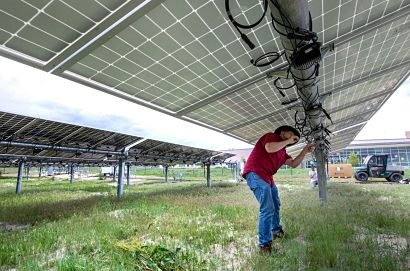
According to the IEA, renewables will be the only energy source likely to experience demand growth for the rest of 2020. The solar industry is taking advantage of this growth by leading the way into digitalisation and adopting more cost-efficient solutions such as bifacial modules.
The bifacial technology market has been growing beyond expectations in recent years due to higher efficiencies and lower levelised costs of electricity (LCOE). Recent data by Infolink and Wood Mackenzie Power & Renewables expects global bifacial demand to reach 12 GW in 2020 and 20 GW in 2024. In terms of market share, according to the International Roadmap for Photovoltaic (ITRPV), bifacial technology adoption is expected to grow from 12 percent in 2019 to nearly 60 percent of total global installations by 2029.
Given the potential of bifacial technologies, the main question is whether the industry will be able to overcome its main challenges: bifacial system gain, simulating the results, standardisation and bankability.
RatedPower, a young solar power design and engineering company utilising its pvDesign software, recently launched its own bifacial energy yield model. This model enables pvDesign users to experience first hand the gain they might obtain using bifacial technology.
Since the introduction of the model on the 19th of May, pvDesign clients have run over 1,000 simulations (155.59 GW) in more than 100 countries in 5 different continents. This represents more than 36 percent of total GW simulated in pvDesign during this period.
However, seven key parameters that affect the energy yield must be considered when developing solar plants with bifacial modules: the irradiance factors, the module efficiency, the ground albedo, the tilt angle, the elevated height to the ground of the structure, the ground cover ratio (GCR) and the array shading. Bifacial modules take advantage of the light reflected from the ground and received by the rear side. The proportion of that light reflected off the ground (albedo) is directly related to the type of soil. The higher the albedo factor, the higher the power gain.
Following the albedo, the height of the structure to the ground is another of the key parameters when simulating with bifacial technology. Increasing the height improves the backside irradiance uniformity, therefore increasing bifacial power gain due to improved perception of ground-reflected light on the rear side.
Additionally, a third parameter to be considered is the GCR, the ratio between the area occupied by PV modules and the total available area. This ratio is directly related to the pitch distance, the inter-row spacing between tables of PV modules. Decreasing the GCR implies a greater pitch distance, thus increased specific energy production.
Industry experts believe that typical project energy production gains are, on average, 3-10 percent and up to 30 percent on optimal scenarios. The report “Modelling of Single-Axis Tracking Gain for Bifacial PV Systems” predicts that for a low ground albedo factor of 0.25 corresponding to vegetation/soil, ground-mounted bifacial solar modules can only achieve bifacial gain up to 10 percent relative to their monofacial counterpart across the entire world. On the other hand, on “Optimisation and performance of bifacial solar modules” the gains in terms of specific production (kWh/kWp) can be estimated to be between 5 percent and 15 percent for “normal” ground albedos (0.2-0.5) in the case of fixed-tilt structures, and between 3 percent and 11 percent for 1 axis trackers in comparison to standard PV plants.
To confirm the above market assumptions and the bifacial gain ratios obtained by the different technological reports, RatedPower simulated with pvDesign its own analysis using the following parameters:
Commercial module 425 W STC, 1500V, and a 75 percent of bifaciality factor.
GCR of 50 percent
Ground Clearance (elevated height to the ground) of 1.10 metres
Fixed structures and trackers
Different locations (California and Iceland) and albedo factors (normal satellital albedo 0.21, optimal desert conditions 0.36 and snow satellital conditions in Iceland of 0.68).
When comparing fixed structures with trackers, our analysis found out that fixed structures obtain a 6 percent higher bifacial gain compared to trackers (4.45 percent to 4.17 percent respectively) in realistic satellital albedo of 0.21. These ratios would increase to 7.3 percent and 6.83 percent respectively in optimal conditions in California with sand albedos of 0.36.
On the other hand, in scenarios with higher albedos (0.68) and latitudes such as Iceland, the percentage of bifacial gains ascended to 16.55 percent in the case of fixed structures and 12.65 percent for trackers.
In terms of specific production kWh/kWp, trackers outperform fixed structures resulting in 12.5 percent and 16.2 percent higher specific production kWh/kWp in albedos of 0.21 and 0.68 respectively.
RatedPower says that pvDesign´s simulation numbers are a perfect worldwide snapshot of what is really happening concerning the adoption of bifacials and the industry preferences: pvDesign simulations obtained bifacial gains up to 10 percent, with better results in high-albedo scenarios (up to 16 percent). Furthermore, fixed structures were found to obtain higher bifacial gains than single-axis trackers (using the same GCR), but still lower yield specific production than trackers.
For additional information:

